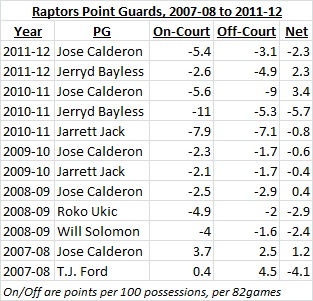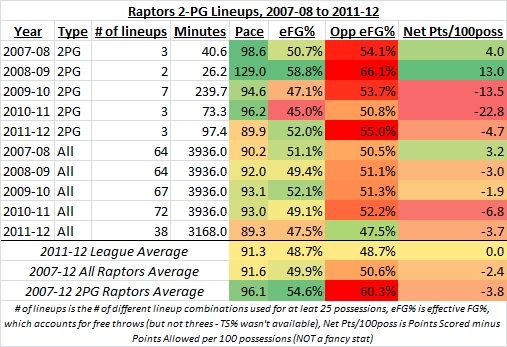With the acquisitions of Kyle Lowry and John Lucas this offseason, the Raptors find themselves with three capable point guards all deserving of minutes.
Moving Jose
The end game is pretty clear – Jose Calderon’s $10M expiring contract, experience, and offensive playmaking ability represent a potentially huge chip in the trade market. If Calderon could be used as a piece in a package to bring back an elite wing player, Bryan Colangelo would likely pull the trigger in a second. However, this scenario has been analyzed to death and nothing has materialized.
In addition, though, the league’s current CBA is structured such that teams with greater flexibility built into their financial structure have somewhat of an advantage in that they may be able to leverage this flexibility to take advantage of other teams. As the luxury tax penalties become more and more prohibitive over the next couple of years, there is the potential for teams to have to dump salary without getting fair value back, so the fact that the Raptors have staggered their contract lengths and have a $10M chunk coming off of the books this summer is important. That is, if Jose can’t be moved as part of a deal for a difference maker, it’s equally as logical to hold on to him and create further financial flexibility rather than trading him for the sake of “getting something.”
With that said, it seems there is somewhere in the neighbourhood of a 50/50 chance that the team plays out the season with all three point guards. Last year the three combined for 81 minutes per game on different teams, so someone, if not two of them, is going to see a significant minutes cut. With only 48 minutes available per game at the point guard spot, there simply isn’t enough playing time unless injuries strike (in which case the Raptors are well-suited to handle it).
Casey on 2-PG Looks
With all three guards performing well, Dwane Casey recently broached the idea of playing two of them together at times to get them all more minutes. It makes sense at first glance, since the Raptors’ biggest weakness is at the wing spots, so shifting a point guard to shooting guard allows for fewer wings to see minutes while affording more minutes to the point guards.
But does it make sense to play two point guards together?
Ask anyone and they will likely give some variation of the answer “sure, in limited minutes” or “yeah, with the right matchup.” Some, of course, would strictly give a Stone Cold Steve Austin “hell yeah” or a Daniel Bryan/Kane “hell no,” but wrestling references aside, it seems there is some common understanding of the benefits and drawbacks of the two-point guard lineup.
Offense vs. Defense
Primarily, running two-point guards will improve your offense and hurt your defense. Again, this is based on match-ups to some degree, and the type of point guards a team employs, but I think anecdotally most would agree a two-guard look sacrifices defense for improved offense.
Obviously on offense, two guards allows for better ball-handlers, generally better shooters, and better creators, improving the versatility and flexibility of offensive sets. To wit, running Kyle Lowry and Jose Calderon together greatly improves the team’s three-point shooting and gives the team two capable ball-handlers to run the pick-and-roll. At the same time, Calderon is a relatively unathletic 6’3” who struggles defensively against point guards and is not big or strong enough to guard shooting guards, while Kyle Lowry is a great defender of point guards but at an even 6’0” would struggle to handle shooting guards. You can make the same narrative substituting John Lucas, a 5’11” high-effort defender, for either Lowry or Calderon and still come to the same conclusion on offense or defense.
Without a point guard capable of defending shooting guards, a two-point guard lineup is likely to get torched by an opposition playing a more standard lineup. But does the offense make up for it?
Recent Raptors 2-PG Usage
This is something the Raptors have toyed with a fair amount over the past few years, playing Jose Calderon with Jarrett Jack, T.J. Ford, and Jerryd Bayless at times, since the team always seems to have two point guards on the roster that are “too good to be a backup.” The table below shows the On/Off Court Rating for Raptors point guards since 2007-08 (I know Forderon existed before this, but this was the cut-off year for something I did later).

Method
This doesn’t really tell us much alone, but what I did next was use Basketball-Reference’s Play Index + tool. Using all lineups that the team used for at least 25 possessions between 2007-08 and 2011-12, I pulled the “Net Points” (simply points scored minus points allowed) for all of them. This gave me 305 different lineup combinations, or about 61 per year, on average, that the team used for at least 25 possessions (roughly a quarter of a game).
Then, excluding Leandro Barbosa (who is a shooting guard, though he is sometimes described as a “combo guard”), I identified every one of these lineup combinations where the Raptors used two point guards. There were 18 such lineups, so, since 2007-08 the Raptors have employed 18 different two-point guard lineups for at least 25 possessions.
Analysis
My goal was to compare how these lineups did against regular Raptors lineups over the time frame. I don’t want to get too stat-heavy, because I’ve already laid out my hypothesis based on watching the games – offense will improve, defense will suffer. I simply wanted some stats to back this up. So, the table below compares the Raptors’ overall performance with their performance in two-point guard lineups over the time frame.

Here we basically confirm what I laid out initially – two-point guard lineups are strong offensively and terrible defensively. (Note: eFG% was all that was available for this analysis. TS% would have been better, but I am relatively certain we’d get the same result.) Every single two-point guard lineup performed below the league average (and almost always below the team season average) in terms of an opponent’s effective field goal percentage, while they, with some exceptions, outperformed those marks on offense.
In terms of overall value to the team, we see that our two smallest sample seasons, 2007-08 and 2008-09, which both had less than a full game’s worth of data, perform well. However, as a whole over the past five years, Raptors two-point guard lineups have been net negatives, seeing the Raptors outscored by four points per 100 possessions compared to two and a half points per 100 possessions overall.
2012-13
It’s difficult to extrapolate these results with certainty for this year’s team (without me diving into an insanely heavy data dump and lineup analysis), since Lucas and Lowry weren’t on any of these teams. However, Calderon is a common thread, and it’s safe to say the team hasn’t played well when he shares the court with another point guard.
To make sure I wasn’t missing something, I looked at Lowry and Lucas’ 82games profiles to see if there were any heavily-used lineup combinations they were a part of with two point guards on the floor (specifically, Lucas-Rose or Lowry-Dragic). It turns out the Lowry-Dragic combination was occasionally effective depending on who else was on the floor with them (though they were all smallish samples, and they were no more effective than Lowry-only lineups). Lucas rarely played with another guard.
Of course, Casey isn’t going to have much choice but to occasionally play a pair of point guards together. As I mentioned, 48 minutes just isn’t enough for these three, and the offensive potential of such lineups will make it tantalizing as a change-of-pace option, especially against slower units.
There’s nothing wrong with changing looks and spreading the minutes around in this manner, just don’t expect much success defensively or the move to be a long-term solution.





